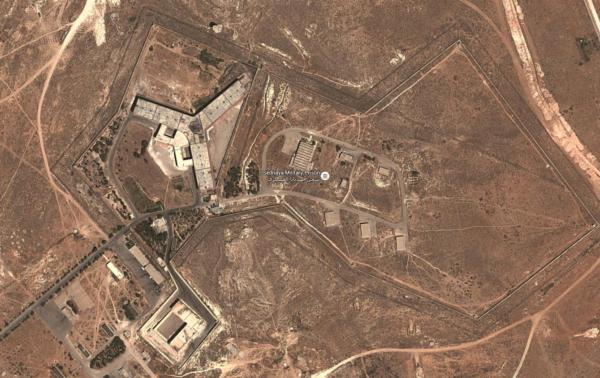The economic costs of detention increase when Syrian authorities seize detainees’ assets. While a third of those surveyed reported that they had property seized, this rate rose to 50% for those detained after 2011
December 13, 2019

Source: Syria Justice and Accountability Centre
Sednaya prison is a notorious military prison outside of Damascus, which former detainees have referred to as “the place where you moved in to die.” Last month, the Association of Detainees and the Missing in Sednaya Prison (ADMSP) released a new report, “Detention in Sednaya: Report on the Procedures and Consequences of Political Imprisonment,” providing new information on human rights violations being committed at the prison. SJAC spoke with the director of ADMSP, Diab Serrih, about the report’s findings. The interview was conducted in Arabic and translated by an SJAC team member.
“Many of those interviewed have different political views and backgrounds,” said Serrih. For this report, ADMSP interviewed 400 former detainees from Sednaya prison. The sample included those detained both before and after the revolution. Similar to findings from previous reports, ADMSP found high rates of physical and psychological torture, as well as sexual violence, all of which rose in severity and scale after the revolution. A third of former detainees reported that they sustained physical injuries during detention so severe their injuries continue to impede their ability to lead a normal life after their release. Serrih said the increase in torture could be a method to terrorize communities and send a message: “When former detainees are returned to their families, either alive or as bodies, there are physical marks of torture on their bodies. This sends a message to the community that if you engage in certain behaviors, the Syrian government will respond in a certain way.” In addition to the conditions within the prison, the report also sheds light on lesser understood impacts of detention, including the economic costs to families, seizure of property, and the lasting psychological scars.
Extortion of Family Members
Most detainees who end up in Sednaya were originally arrested through a local security branch, and the report states that “the vast majority of detainees passed through more than one security branch.” The complex movements between security branches and Sednaya make it difficult for families attempting to keep track of their loved one. Serrih explained that before the revolution, families were more likely to know where their loved ones were being held. Since 2011 however, families often lose contact with a detainee immediately after they are detained. Many families pay extortion money to the police, security branch, or mukhabarat in order to find out the status of detained loved ones, and to attempt to arrange a visit with the detainee. “[Extortion] usually happens when the detainee is still in the security branch and not yet in Sednaya,” said Serrih. “Some families paid large sums of money – over $10,000 – and very rarely did it work out. Of those who paid that amount, 32% said they were able to get information on a detainee and 21.17% said the money they gave led to release from Sednaya.” These extortion payments represent a large economic burden to families, one that is often compounded by the loss of the income previously earned by the detainee.
Property Seizure
The economic costs of detention increase when Syrian authorities seize detainees’ assets. While a third of those surveyed reported that they had property seized, this rate rose to 50% for those detained after 2011. Serrih said the authorities are strategic about which assets they seize when detaining a person. “If they detain a taxi driver, they are also going to seize ownership of his car; which is essentially his livelihood.” Serrih noted the government may also seize a detainee’s business or family home. “Subsequently, the authorities would not inform the person or their family of the whereabouts of the seized property or how to regain ownership,” he said. “This further exacerbates an individual or family’s ability to support themselves financially.”
Long Term Impacts of Detention
According to the report, more than 40% of detainees felt that detention in Sednaya affected their civil status and relationships. Serrih explained the experience is different for those detained in Sednaya before the revolution and those detained after. “Those who had longer sentences in Sednaya – which are generally pre-revolution detainees – have family issues when they are released,” he said. “These individuals went into prison when they had small kids, who now do not recognize them.” Serrih also mentioned the effects detention had on the wives of detainees, who may have been forced to take over all parenting responsibilities and possibly become the main breadwinner of the family. “In these cases, the former detainee does not know how to navigate their role in family life and in society.” Serrih said there are cases of pre-revolution detainees who are separated from their spouses but not divorced, attributing the cause to the long prison sentence.
These long sentences became less common after the revolution. However, 96% of post-2011 detainees report that they were not informed of the duration of their sentence, and their family members were less likely to know their whereabouts. More importantly, many detained in Sednaya after the revolution do not make it out alive. According to a report released by Amnesty International on Sednaya prison, evidence showed mass hangings of detainees before transferring the deceased to mass graves, estimating about 13,000 to have been killed between 2011 and 2015.
While the ADMSP report provides important new details on detention in Sednaya, it also reinforces previous documentation regarding government detention facilities and the need for economic and psychological support to former detainees and families of the missing. The release of detainees and creation of a missing persons program that promises to investigate the fate of the missing should be at the cornerstone of any future peace agreement, and such efforts must be designed through close collaboration with former detainees and their family members.
The full report can be accessed here.
